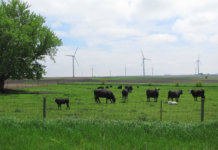 Sen. Lisa Murkowski's new energy blueprint, dubbed ‘Energy 20/20: A Vision for America's Energy Future,’ is certainly inclusive. The Alaska senator's ‘all of the above’ plan calls for the continued domestic development of nearly every source of energy – including oil, gas, coal, nuclear, wind, solar and hydropower.
Sen. Lisa Murkowski's new energy blueprint, dubbed ‘Energy 20/20: A Vision for America's Energy Future,’ is certainly inclusive. The Alaska senator's ‘all of the above’ plan calls for the continued domestic development of nearly every source of energy – including oil, gas, coal, nuclear, wind, solar and hydropower.
In the document, Murkowski, ranking member of the Senate Energy and Natural Resources Committee, outlines many of the steps she thinks the U.S. should take to become entirely independent of OPEC by 2020.
One notable facet of Murkowski's plan is her call for a new definition of clean energy – which may or may not be favorable for the wind energy industry.
""Clean energy' should have a specific, verifiable definition based on actual impacts," she wrote in the energy blueprint. "Clean' should be defined as "less intensive in global life-cycle impacts on human health and the environment than its likeliest alternative.' By 2020, the federal government should implement this definition of clean energy across all its programs and policies."
Murkowski does not expressly indicate whether she thinks the current definition of "clean energy" is too broad or too specific, nor how the "likeliest alternative" would be determined. However, it should be noted that she makes references to "clean coal" and thinks there should be no controversy surrounding hydropower's classification as a renewable source of energy.
"Hydropower is often excluded from consideration as a renewable resource because it has been politically controversial," she wrote. "Political considerations should not be used to exclude a particular resource from the definition of "clean' or "renewable.' Hydropower is the largest source of clean, renewable electricity in the United States."
Many states have taken steps to broaden the definition of clean energy after the prospects for meeting their renewable portfolio standards (RPS) became slim. For instance, Oregon modified its RPS to allow incineration facilities using municipal solid waste to qualify for its RPS.
Abolish clean energy subsidies
Although newly appointed Energy and Natural Resources Committee Chairman Ron Wyden, D-Ore., has been a strong supporter of federal renewable energy incentives – and has even co-sponsored legislation to, among other measures, extend the wind energy production tax credit (PTC) and institute a federal clean energy standard – he is likely to be challenged by Murkowski.
In her blueprint, Murkowski said she supports clean energy research and development (R&D), which is more than can be said for some House Energy and Commerce Committee members who have used failed solar company and loan-guarantee recipient Solyndra as an excuse to oppose all clean energy research initiatives.
However, Murkowski said clean energy investment should be limited to R&D, as production-based incentives, such as the PTC, could end up hindering the long-term growth of the industry.
"Perpetual reliance on production and deployment subsidies can actually inhibit the long-term growth and development of new energy modes," the blueprint states. "Instead, the federal government should focus its attention and limited resources on R&D for clean energy.
"By 2020, we need to eliminate most of the government's current subsidies and implement a new system of clean energy finance that is cost-effective, technology-neutral and conducive to private investment," the document adds.
Todd Foley, senior vice president of policy and government relations at the American Council on Renewable Energy (ACORE), says that although Murkowski's historic support for renewable energy is commendable, stripping tax-based incentives is not the answer.
"We continue to support the production and investment tax credits for at least a period of time," he tells NAW. "They're still needed in the market. Now is not the time to pull the rug out from under the feet of the industry."
Rather than subsidize clean energy, Murkowski said, the federal government should simplify the process for awarding leases for the development of wind, solar, geothermal projects on public lands. In addition, policymakers should introduce legislation to streamline the permitting process for offshore wind projects, she recommended.
Nonetheless, Murkowski stressed that wind energy and solar power are intermittent resources that need to be balanced with energy-storage technologies.
"Wind power is intermittent; the winds are unpredictable," her blueprint states. "Moreover, wind speed fluctuates on multiple timescales: hourly, daily and seasonally. Due to this unpredictable variability, wind power must be stored in order to meet electricity demand. As previously noted, storing electricity is very challenging today. To make wind power cost-competitive, we should focus on R&D for energy-storage technologies."
Master limited partnerships
One alternative to subsidizing renewable energy is to modify the tax code to allow renewables to qualify for master limited partnerships (MLPs), which allow regular investors to purchase shares in publicly traded partnerships. Although MLPs have been used for decades in the oil and gas industries, they are not currently available to renewable energy. In her energy blueprint, Murkowski encourages such a modification.
"Congress should consider wholesale reform of the Internal Revenue Code as part of a broader approach to resolve inconsistent tax characteristics within the energy sector, [and] make MLPs more widely available by amending the Internal Revenue Code of 1986 to extend the MLP structure to include biodiesel, biomass, hydropower, solar, wind and virtually every other kind of alternative energy source, with the exception of nuclear energy," the blueprint states.
Foley says Murkowski's support for MLPs shows promise for bipartisan support for this change.
"[Murkowski's] support for enabling renewable energy to access that very successful policy is very important," he says. "We have seen significant bipartisan support for enabling renewable energy to access master limited partnership financing. MLPs have been highly successful in driving capital formation and deployment to the extraction industries, and there's no doubt in our minds that access for renewable energy [to MLPs] would also help bring much greater levels of capital – and cheaper capital – to renewable energy.
Murkowski also recommended the use of reverse auctions, in which multiple sellers compete to be selected by one buyer – in contrast to a traditional auction, in which multiple buyers bid for acceptance by a single seller. In a reverse auction, a renewable energy generator would compete with potential suppliers to draw out the lowest price or best value.
In releasing her energy blueprint, Murkowski stressed that the document is not intended to be an introduction of policy, but rather a discussion-starter. Because of her high rank in energy matters, it is likely to do just that. But for right now, perhaps all that can be agreed on with any certainty is what Murkowski states as the opening line of her plan: "Energy is good."



